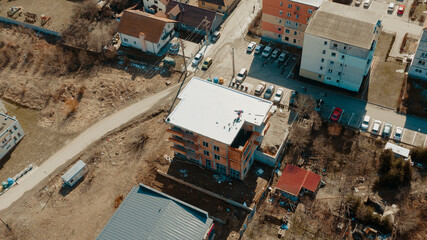
A commercial flat roof is a structure made from roofing materials such as asphalt shingles, metal or concrete tiles. It covers the entire roof structure to protect it from weather and facilitate water drainage. Also called mod-bite roofing, this type of roofing system usually consists of high-density bitumen and reinforced roof membranes in multiple layers. It’s commonly fastened to roofs as two-ply systems for greater protection and longevity. Mod-bit roofs are easy to keep and provide higher tensile strength than other commercial flat roofs.
Several factors determine the lifespan of a commercial roof. Although some may seem insignificant, it’s important to take note of them all because the lifespan of the roofs can affect the overall value of your property. Here are some examples:
It’s advisable to contact commercial roofing services when there is a serious threat of leaking because they have the skills and experience to address these types of problems. These roofers are experts when it comes to installing a leak detection system in case water seepage happens. They are also adept in finding possible weak spots where leaks may occur, like around windows, ceilings, and ventilation vents. Lastly, commercial roofing services also have the skill to identify damaged areas and fix them on your behalf if needed.
The right commercial roofing systems don’t only address leak threats; they’re also designed to prevent them. They do this by improving energy efficiency. To keep your business cost at its optimal level, ensure that all appliances and machinery are properly maintained. Regular roof inspections and maintenance can help you avoid unnecessary repairs or replacements that will cost you more than what your commercial roof system is worth.
Aside from the lifespan of your flat roof, another factor to consider is the longevity of its materials. Some roof materials such as asphalt and clay tiles are more durable than others. However, it depends on the manufacturer as well as the condition of the materials when installed. For instance, tile and asphalt roofing materials are more durable when they are coated with various coatings designed to resist fire, erosion, and more. The same applies to clay tiles which are also durable and long-lasting. However, the good news about clay tiles is that they are low-priced compared to asphalt and tile roofs.
Since commercial roofing systems nowadays include several components such as insulation, roof materials, and roofing systems, a thorough inspection should be done even after the roof has been installed. In fact, commercial roofs tend to leak after some time due to the movement of the building and wind.
Today, commercial roofing systems can provide homeowners and commercial owners with a very cost-efficient alternative to traditional single-ply roofing. The primary difference between the two is the installation process. Single-ply roofs are usually installed by carpenters, while multi-ply roofs are usually installed by installers who use ladders and mechanical devices. There are even DIY home improvement projects wherein the main objective is to replace only one-third of the roof. However, professional roofing contractors are the best to do this kind of project.
With commercial roofing systems today becoming more popular, many homeowners are considering having a flat roof installed. However, if you plan to have your own flat roof constructed, be sure to research first. You may not know this, but many commercial roofing systems are sold in the market. The most common is the open-hedged membrane or the BUR (built-up layer). Other types of commercial roofing systems used in homes include the closed-cell resin system, metal roofs, aluminum roofs, clay tiles, and metal flashings.